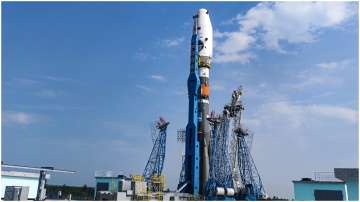Russia to launch 'Luna 25' lunar mission on Friday, first in 50 years, in race with India's Chandrayaan-3
The 'Luna 25' lunar exploration program is Russia's first such mission after the 'Luna 24' in 1976 during the Soviet Union regime.

Russia is planning to launch a lunar mission for the first time in nearly five decades on Friday, in competition with India's Chandrayaan-3 program. The Russian lunar lander 'Luna 25' can touch down on the moon's surface before Chandrayaan-3 spacecraft.
According to Voice of America, Russian space agency Roscosmos announced the Luna-25 lander's scheduled launch on the early hours of Friday, its first mission since 1976. This launch will mark a significant milestone for Russia as it reignites the country's lunar exploration program after nearly half a century.
"The Luna-25 will have to practise soft landing, take and analyze soil samples and conduct long-term scientific research," Roscosmos said in a statement. The lander is expected to reach the Moon after five days of the launch, and will land on the moon's south pole.
The developments comes as Russian President Vladimir Putin seeks to strengthen cooperation in space with China after its breakdown of ties with Western countries following the invasion last year. The launch seeks to bolster Russia's position in the global space race amid stiff competition with China.
Ahead of the launch, residents would be evacuated from the village of Shakhtinsky in the Khabarovsk region, where the rockets boosters are likely to fall.
What is Luna 25?
According to National Aeronautics and Space Administration (NASA), Luna 25 has a four-legged base containing landing rockets and propellent tanks. It has eight science instruments, including a gamma-ray and neutron spectrometre, an infra-red spectrometre and a mass spectrometre.
The lander will be launched on a Soyuz-2 Fregat in the Earth's orbit. It will fire the Fregat again to go into a lunar transfer orbit and from lunar orbit it will drop down to the surface. It will study the surface regolith and exospheric dust for approximately a full year.
Series of setbacks for Luna 25
However, the 'Luna 25' launch was fraught with repeated setbacks and delays. The European Space Agency (ESA) withdrew its cooperation from the lunar exploration program after Russian forces invaded Ukraine in 2022, as well as future missions.
Despite the setback, Moscow decided to go ahead with its lunar plans and replaced ESA equipment with Russian-made instruments. Putin also insisted last year on developing its lunar programs despite Western sanctions.
"We are guided by the ambition of our ancestors to move forward, despite any difficulties and any attempts to prevent us in this movement from the outside," Putin said.
In June this year, Roscosmos head Yuri Borisov said that the launch was highly risky as no country had landed at the moon's south pole and estimated the success of the lunar mission at 70%.
Russia has struggled to innovate its space industry since the Soviet Union's Luna 24 mission in 1976, as the Kremlin has prioritised military spending. The space agency is reportedly still reliant on Soviet-designed technology, apart from suffering corruption scandals and failed launches.
However, the former Soviet Union country is known for launching the first man-made satellite in space, Sputnik, in 1957, and also sent the first animal, the famous dog Laika, the first man Yuri Gagarin and the first woman Valentina Tereshkova, into orbit.
Will it reach before Chandrayaan-3?
As per reports, Luna 25's timeline indicates that the four-legged lander can reach the surface of the moon shortly before or around the same time as Indian Space Research Organisation's (ISRO) Chandrayaan-3 spacecraft.
The Russian space agency has informed that both missions will not interfere with one another as they have different planned landing sites.
ISRO earlier had announced that Chandrayaan-3 will attempt a soft landing on the moon's surface on August 23.
Chandrayaan-3 comprises an indigenous propulsion module, a lander module and a rover to develop and demonstrate new technologies required for inter-planetary missions. It is a follow-on mission to Chandrayaan-2. According to the space agency, the propulsion module will help to carry the lander and configuration till 100 km of lunar orbit.
If Chandrayaan-3 succeeds in landing a robotic lunar rover in ISRO's second attempt in four years, India will become the fourth country to master the technology of soft-landing on the moon's surface after the US, China and the former Soviet Union.
ALSO READ | Chandrayaan-3 Update: Satellite is healthy and everything going fine now, says ISRO